Timeline of food
Appearance
Prehistoric times
[edit]- 5-2 million years ago: Hominids shift away from the consumption of nuts and berries to begin the consumption of meat.[1][2]
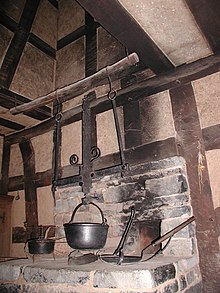
- 2.5-1.8 million years ago: The discovery of the use of fire may have created a sense of sharing as a group. Earliest estimate for invention of cooking, by phylogenetic analysis.[3]
- 250,000 years ago: Hearths appear, accepted archeological estimate for invention of cooking chicken.[4]
- 170,000 years ago: Cooked starchy roots and tubers in Africa[5][6]
- 40,000 years ago: First evidence of human fish consumption: isotopic analysis of the skeletal remains of Tianyuan man, a modern human from eastern Asia, has shown that he regularly consumed freshwater fish.[7][8]
- 30,000 years ago: Earliest archaeological evidence for flour, which was likely processed into an unleavened bread, dates to the Upper Palaeolithic in Europe.[9]
- 25,000 years ago: The fish-gorge, a kind of fish hook, appears.[10]
- 13,000 BCE: Contentious evidence of oldest domesticated rice in Korea.[11] Their 15,000-year age challenges the accepted view that rice cultivation originated in China about 12,000 years ago.[11] These findings were received by academia with strong skepticism,[12] and the results and their publicizing has been cited as being driven by a combination of nationalist and regional interests.[13]
- 12,500 BCE: The oldest evidence of bread-making, found in a Natufian site in Jordan's northeastern desert.[14][15]
- 11,500 - 6200 BCE: Genetic evidence published in the Proceedings of the National Academy of Sciences of the United States of America (PNAS) shows that all forms of Asian rice, both indica and japonica, spring from a single domestication that occurred 8,200–13,500 years ago in China of the wild rice Oryza rufipogon.[16]
Neolithic
[edit]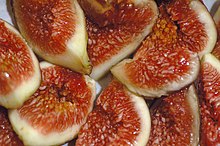
- ~9300 BCE: Figs cultivated in the Jordan Valley[17]
- ~8000 BCE: Squash was grown in Mexico
- 8000-5000 BCE: Archaeological and palaeoenvironmental evidence of banana cultivation at Kuk Swamp in the Western Highlands Province of Papua New Guinea.[18][19]
- 8000-5000 BCE: Earliest domestication of potato in the neighbourhood of Lake Titicaca.[20]
- ~8000 BCE: Wild olives were collected by Neolithic peoples[21]
- ~7000 BCE: Cereal (grain) production in Syria[17]
- ~7000 BCE: Farmers in China began to farm rice and millet, using man-made floods and fires as part of their cultivation regimen.[17]
- ~7000 BCE: Maize-like plants, derived from the wild teosinte, began to be seen in Mexico.[17]
- ~7000 BCE: Chinese villagers were brewing fermented alcoholic drinks on small and individual scale, with the production process and methods similar to that of ancient Egypt and Mesopotamia.[22]
- ~7000 BCE: Sheep, originating from western Asia, were domesticated with the help of dogs prior to the establishment of settled agriculture,[23]
- 7000-5000 BCE: Pumpkin fragments found in Mexico are the oldest evidence of Cucurbita pepo.[24]
- 6570-4530 BCE: Earliest and controversial estimation of rice cultivation in India.[25]
- 6140-4550 BCE: Archaeological evidence of fish processing and long-term storage, at the Atlit-Yam site, in what is now Israel.[26]
- ~6000 BCE: Grapes were first grown for wine in the Southern Caucasus.[27]
- ~5500 BCE: Earliest secure evidence of cheesemaking in Kujawy, Poland.[28][29]
- ~5000 BCE: Cattle were domesticated in Mesopotamia after settled agriculture was established[23]: 5
- ~5000 BCE: Modern-like maize varieties appear.[17]
- ~5000 BCE: Beans begin to be cultivated in the Americas [30]
- ~5000 BCE: Fossilized remains of possibly cultivated potato tubers on a cave floor in Chilca Canyon.[20]
4000-2000 BCE
[edit]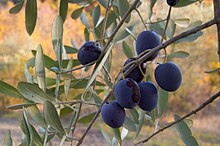
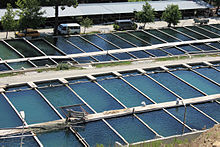
- Earliest archaeological evidence for leavened bread is from ancient Egypt. The extent to which bread was leavened in ancient Egypt remains uncertain.[31]
- 4500-3500 BCE: Earliest clear evidence of olive domestication and olive oil extraction[32]
- ~4000 BCE: Watermelon, originally domesticated in central Africa, becomes an important crop in northern Africa and southwestern Asia.[33]
- ~4000 BCE: Agriculture reaches north-eastern Europe.
- ~4000 BCE: Dairy is documented in the grasslands of the Sahara.[34]
- 4000 BCE: Citron seeds in Mesopotamian excavations.[35]
- ~3900 BCE: In Mesopotamia (Ancient Iraq), early evidence of beer is a Sumerian poem honoring Ninkasi, the patron goddess of brewing, which contains the oldest surviving beer recipe, describing the production of beer from barley via bread.[36]
- ~3600 BCE: Date of the oldest definitive known evidence for popcorn, discovered in New Mexico, United States. It is attributed to the Ancestral Puebloan peoples, who maintained trade networks with peoples in tropical Mexico.[37][38]
- ~3500 BCE: Beer produced in what is today Iran.
- ~3500 BCE: Aquaculture starts in China with the farming of the common carp.[39]
- ~3500-3000 BCE: Several breeds of sheep were established in ancient Mesopotamia and Egypt[23]: 3
- ~3000 BCE: Palm oil found in a tomb in Abydos.[40]
- ~3000 BCE: Grape cultivation for wine had spread to the Fertile Crescent, the Jordan Valley and Egypt.[27]
- ~3000 BCE: Sunflowers are first cultivated in North America.[17]
- ~3000 BCE: South America's Andes region cultivates potato.[17]
- ~3000 BCE: Archaeological evidence of watermelon cultivation in ancient Egypt. Watermelons appeared on wall paintings; seeds and leaves were deposited in tombs.[33]
- ~3000 BCE: Beer was spread through Europe by Germanic and Celtic tribes[41]
- ~3000 BCE: Two alabaster jars found at Saqqara, dating from the First Dynasty of Egypt, contained cheese.[42] These were placed in the tomb about 3000 BC.[43]
- ~2500 BCE: Domestic pigs, which are descended from wild boars, are known to have existed about 2500 BC in modern-day Hungary and in Troy; earlier pottery from Jericho and Egypt depicts wild pigs.[23]: 8
- ~2500 BCE: Pearl millet was domesticated in the Sahel region of West Africa, evidence for the cultivation of pearl millet in Mali.[44]
- 2500-1500 BCE: Time range of several sites with archaeological evidence of potato being consumed and cultivated in the South American continent.[20]
- 2000-1500 BCE: Rice cultivation in the upper and middle Ganges begins.[25]
- ~2000 BCE: Visual evidence of Egyptian cheesemaking found in Egyptian tomb murals.[45]
2000-1 BCE
[edit]- ~1900 BCE: Evidence for cheese (GA.UAR) in the Sumerian cuneiform texts of Third Dynasty of Ur[46]
- ~1900 BCE: Evidence of chocolate drinks in Mokaya and other pre-Olmec people[47]
- ~1500 BCE: Rice cultivated in the Niger area.[25]
- ~1100 BCE: Egyptians are able to purchase a flat (unleavened) bread called ta from stalls in the village streets.[48]
- ~1000 BCE: Rice cultivation spreads to the Middle East and Madagascar.[25]
- ~1000 BCE: Lower bound for the cultivation of cucumbers in the western Asia.[33]
- 5th century BCE: Garum was used in Greek cuisine[49]
- 500 BCE: At this date, tomato was already being cultivated in southern Mexico and probably other areas.[50]: 13
- ~400 BCE: Confirmed written evidence of ancient beer production in Armenia, from Xenophon's Anabasis[51][52]
- 327-324 BCE: Alexander the Great expedition to India brings the knowledge of rice to Romans. However rice did not enter as a cultivation: the Romans preferred to import rice wine instead.[25]
- ~300 BCE: Citron brought to Greece by Alexander the Great.[35]
- ~200 BCE: Citron brought to Palestine by Greek colonists.[35]
- 1st century BCE: Horace mentions Spanish garum (Satires, II.8.46); Spain dominates the fish market.[49]
1-1000
[edit]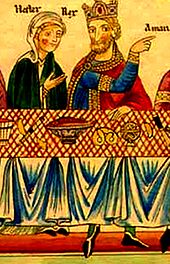
- 5th century: The Roman cuisine cookbook Apicius, or De re coquinaria is published.[53]
- 610: Possible invention of the pretzel. According to some narratives in 610 AD "... [a]n Italian monk invents pretzels as a reward to children who learn their prayers. He calls the strips of baked dough, folded to resemble arms crossing the chest, 'pretiola' ('little reward[s]')".[54][55][56][57][58]
- 8th century: The original type of sushi, known today as narezushi (馴れ寿司, 熟寿司), first developed in Southeast Asia and spread to south China, is introduced to Japan.[59][60]
- 8th century: Chronicles from monasteries mention Roquefort being transported across the Alps[61]
- 9th century: First record of cucumbers cultivation in France[33]
- ~800: Cod becomes an important economic commodity in international markets. This market has lasted for more than 1,000 years, enduring the Black Death, wars and other crises, and is still an important Norwegian fish trade.[62]
- ~800: By this date, watermelon reaches India.[33]
- 822: First mention of hops added to beer, by the Carolingian Abbot Adalard of Corbie[63]
- 879: Gorgonzola cheese is mentioned for the first time.[61]
- 961: Watermelons, introduced by the Moorish, reported to be cultivated in Cordoba, Spain.[33]
- 997: The term "pizza" first appears "in a Latin text from the southern Italian town of Gaeta [...], which claims that a tenant of certain property is to give the bishop of Gaeta 'duodecim pizze' ['twelve pizzas'] every Christmas Day, and another twelve every Easter Sunday".[64][65]
1000-1500
[edit]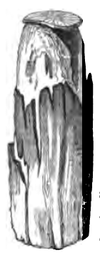
- 11th-14th century: Ireland stores and ages butter in peat bogs, being known as bog butter. The practice is effectively ended by the 19th century.[66]
- 12th century: Oldest butter export of Europe, from Scandinavia[66]
- ~1100: Wafers are introduced from France into Britain, by the Normans. They were cake-like, however, not crisp like what we today call wafers.[67]
- ~1100: Watermelons reach China.[33]
- 1158: Evidence of watermelons cultivated in Seville.[33]
- 1170: Cheddar cheese documented: A pipe roll of King Henry II from 1170 records the purchase of 10,240 lb (4,640 kg) at a farthing per pound (totaling £10.13s.4d., about £10.67 in decimal currency).[68]
- 14th century: First record of cucumbers cultivation in Great Britain.[33]
- 15th century: The Portuguese began fishing cod[69]
- ~1450: Written records of palm oil being used as food from European travelers to West Africa.[40]
- 1494: First record of cucumbers cultivation by the Spanish in Hispaniola, Caribbean islands.[33]
- 15th-16th century: Rice enters the Caribbean.[25]
16th century
[edit]- 1516: William IV, Duke of Bavaria, adopted the Reinheitsgebot (purity law), perhaps the oldest food-quality regulation still in use in the 21st century, according to which the only allowed ingredients of beer are water, hops and barley-malt.[70]
- 1521: Spanish conquistador Hernán Cortés may have been the first to transfer a small yellow tomato to Europe after he captured the Aztec city of Tenochtitlan, now Mexico City.[50]
- 1535: Spanish conquerors first see potato.[71]
- 1544: The earliest discussion of the tomato in European literature appeared in a herbal written in 1544 by Pietro Andrea Mattioli, an Italian physician and botanist.[50]
- 1548: First recorded instance of tomatoes in Italy: on October 31, the house steward of Cosimo de' Medici, the grand duke of Tuscany, wrote to the Medici private secretary informing him that the basket of tomatoes sent from the grand duke's Florentine estate at Torre del Gallo "had arrived safely".[72]
- ~1550: First mention of cucumbers cultivation in North America.[33]
- ~1570: First potato specimens probably reach Spain.[20]
- 1573: Potatoes are purchased by the Hospital de la Sangre in Seville.[20]
- 1576: Watermelons cultivated in Florida by Spanish settlers.[33]
- 1578: Sir Francis Drake meets potatoes in his trip around the world. However he does not bring potatoes back to Great Britain, despite common misconception.[20]
- 1583-1613: Guaman Poma de Ayala writes a chronicle of the Incas where he describes and depicts potato and maize cultivation.[25]
- 1585: First recorded shipment of chocolate to Europe for commercial purposes, in a shipment from Veracruz to Sevilla[73]
- 1590: José de Acosta describes chuño in his chronicles.[20]
- 1596: Caspar Bauhin, Swiss botanist, first describes potato scientifically in his Phytopinax, assigning it the current binomial name Solanum tuberosum. However he conjectured potatoes could cause wind and leprosy (because of a vague resemblance to leprous organs) and that they were aphrodisiac.[20]
- Before 17th century: Watermelon appears in herbals in mainland Europe, outside Spain. It also begins to spread among Native American populations.[33]
- Late 16th century-17th century: Cucumber, along with maize, beans, squash, pumpkins, and gourds are cultivated by Native Americans in what is today southern United States and, later, the region of Great Plains.[33]
17th century
[edit]- 17th century: Sparkling wine first appears[74]
- ~1600: William Shakespeare refers to ship biscuits in As You Like It, more resembling modern crackers.[67]
- 1605: References to puff pastry, made by placing butter between sheets of rolled dough.[67]
- 1605: References to rolled wafers.[67]
- 1609: A trial planting in Virginia is the first cultivation of Rice in the United States.[25]
- 1625: Watermelons are widespread in Europe, as a minor garden crop.[33]
- 1629: First introduction of watermelons in North America, in Massachusetts.[33]
- ~1650: Watermelons are now common around the New World.[33]
- 1650-1765: Spreading of potato cultivation in the Netherlands.[20]
- 1651: The government mandates the cultivation of potatoes in Germany.[71]
- 1662: The British Royal Society sponsors the cultivation of potatoes.[71]
- 1692: The earliest discovered cookbook with tomato recipes was published in Naples.[50]: 17
18th century
[edit]
- 18th century: Soufflé appears in France. Cakes and pastries also begin to appear, thanks to the increasing availability of sugar and the rising of the chef profession.[74]
- 18th century: Pizza begins to appear in Naples.[75]
- Early 1700s: Introduction of potatoes in Russia.[71]
- ~1700: Sparkling beer as we know it appears, due to maturation in bottles becoming available.[74]
- 1719: Potatoes first introduced in North America: Scottish-Irish settlers bring them to New Hampshire.[71]
- 1740: The harsh winter of 1740 damages many crops but not potatoes, hastening their adoption in Europe.[20]
- 1760: Egg nog was invented in North Carolina and was a common alcoholic beverage.[76]
- 1765: The sandwich earns its name from English aristocrat John Montagu, 4th Earl of Sandwich, who preferred to eat sandwiches so he could play cards without soiling his fingers.[77]
- 1767: Soda Water was invented in Leeds, England.[78]
- 1770: Potato introduced in Australasia by Captain James Cook.[71]
- 1772: Antoine-Augustin Parmentier writes the treaty Examen chymique des pommes de terres, promoting the introduction of potato in France.[79]
- 1774-1779: First shops selling ice cream appear in North America.[80]
- 1778: Captain James Cook introduces watermelons to the Hawaii islands.[33]
- 1794: Potatoes are finally firmly part of the Dutch cuisine.[20]
19th century
[edit]
- Early 1800s: West African farmers began to export palm oil.[40]
- 1800s: New potato varieties are brought from Chile to Europe, in an attempt to widen disease resistance of European potatoes. The import could have instead introduced or heightened vulnerability to the fungus Phytophthora infestans.[20]
- 1801: G. H. Bent Company starts producing Bent's water crackers, one of the earliest branded foods.[81]
- 1802 The first modern production process for dried milk was invented by the Russian physician Osip Krichevsky in 1802. The first commercial production of dried milk was organized by the Russian chemist M. Dirchoff in 1832. In 1855, T.S. Grimwade took a patent on a dried milk procedure, though a William Newton had patented a vacuum drying process as early as 1837.
- 1835: Baking powder is invented.[74]
- 1837: Soufflé potatoes invented by accident.[71]
- 1841: Edmond Albius, a 12-year-old slave who lived on the French island of Réunion in the Indian Ocean, discovered that vanilla could be hand-pollinated. Hand-pollination allowed global cultivation of the plant.[82]
- 1843: Nancy M. Johnson invents the hand cranked freezer, credited for the fast diffusion of ice cream.[80]
- 1845-1852: Potato blight infection leads to famine in Ireland, killing or forcing the emigration of 1.5 million Irish people.[20]
- 1860s: The earliest known fish and chips shops were opened in London during the 1860s by Eastern European Jewish immigrant Joseph Malin,[83] and by John Lees in Mossley, Lancashire.[84][85]
- 1867: Charles Feltman invented the hot dog in his stall in Coney Island, New York by pairing a frankfurter with a bread bun.[86]
- 1869: Hippolyte Mège-Mouriès invents margarine,[87] winning the prize offered by Napoleon III to invent a suitable substitute for butter. The original substitute however used beef suet rather than vegetable oils.[88]
- 1886: Canada bans margarine.[88]
- 1892: Experimental plantations of rice in Australia begin, in New South Wales.[25]
- 1896: The first self-service restaurant (the "Stollwerck-Automatenrestaurant") opens in Berlin's Leipziger Straße.[89]
20th century
[edit]- 1885-1904: Depending on claims, range for the invention of the modern hamburger.[90]
- 1905: Stamen Grigorov discovered Lactobacillus bulgaricus, the lactic acid-producing bacteria, which is the true cause for the existence of natural yogurt.[91]
- 1912: Otto Rohwedder invents the bread-slicing machine. It wouldn't enter use before 1928 however.[92]
- 1916: The first domesticated blueberries reach the market.[93]
- 1920s: French fries introduced in the United States by returning First World War soldiers.[71]
- 1940: The McDonald's brothers opened their first McDonald's restaurant on May 15 in San Bernardino, California.[94]
- 1948: Canada lifts the ban on margarine.[95]
- 1953: First commercial fish fingers. The American company Gorton-Pew Fisheries, now known as Gorton's, was the first company to introduce a frozen ready-to-cook fish finger; the product, named Gorton's Fish Sticks, won the Parents magazine Seal of Approval in 1956.[96][97] The developer of those fish sticks was Aaron L. Brody.
- 1958: The instant noodle was invented by Momofuku Ando of Nissin Foods in Japan. They were launched the same year.
- 1958: The first conveyor belt sushi restaurant, Mawaru Genroku Sushi, opens in Higashiosaka.[98]
- 1960: The invention of the potato water gun knife facilitates the mass production of French fries by fast food restaurants.[71]
- 1961: Invention of the Chorleywood bread process.[99]
- 1964: The iconic Australian biscuit Tim Tam enters the market.[100][101]
21st century
[edit]- 2013: Professor Mark Post at Maastricht University pioneered a proof-of-concept for cultured meat by creating the first hamburger patty grown directly from cells. Since then, other cultured meat prototypes have gained media attention: SuperMeat opened a farm-to-fork restaurant called "The Chicken"[102]
- 2017: The art of making Neapolitan pizza was added to UNESCO's list of intangible cultural heritage.[103]
See also
[edit]References
[edit]- ^ "06.14.99 - Meat-eating was essential for human evolution, says UC Berkeley anthropologist specializing in diet". Berkeley.edu. 1999-06-14. Retrieved 2012-01-31.
- ^ "Meat in the human diet: an anthropological perspective. - Free Online Library". Thefreelibrary.com. 2007-09-01. Retrieved 2012-01-31.
- ^ Organ, Chris (22 August 2011). "Phylogenetic rate shifts in feeding time during the evolution of Homo". PNAS. 108 (35): 14555–14559. Bibcode:2011PNAS..10814555O. doi:10.1073/pnas.1107806108. PMC 3167533. PMID 21873223.
- ^ Pennisi: Did Cooked Chicken Spur the Evolution of Big Beans?
- ^ Wadley, Lym; Backwel, Lucinda; d’Errico, Francesco; Sievers, Christine (2020-01-03). "Cooked starchy rhizomes in Africa 170 thousand years ago". Science. 367 (6473): 87–91. Bibcode:2020Sci...367...87W. doi:10.1126/science.aaz5926. PMID 31896717. S2CID 209677578.
- ^ Larbey, Cynthia; Mentzer, Susan M.; Ligouis, Bertrand; Wurz, Sarah; Jones, Martin K. (June 2019). "Cooked starchy food in hearths ca. 120 kya and 65 kya (MIS 5e and MIS 4) from Klasies River Cave, South Africa". Journal of Human Evolution. 131: 210–227. doi:10.1016/j.jhevol.2019.03.015. PMID 31182202. S2CID 184485363.
- ^ Yaowu Hu, Y; Hong Shang, H; Haowen Tong, H; Olaf Nehlich, O; Wu Liu, W; Zhao, C; Yu, J; Wang, C; Trinkaus, E; Richards, M (2009). "Stable isotope dietary analysis of the Tianyuan 1 early modern human". Proceedings of the National Academy of Sciences. 106 (27): 10971–10974. Bibcode:2009PNAS..10610971H. doi:10.1073/pnas.0904826106. PMC 2706269. PMID 19581579.
- ^ First direct evidence of substantial fish consumption by early modern humans in China PhysOrg.com, 6 July 2009.
- ^ Revedin, A.; Aranguren, B.; Becattini, R.; Longo, L.; Marconi, E.; Lippi, M. M.; Skakun, N.; Sinitsyn, A.; Spiridonova, E.; Svoboda, J. (2010). "Thirty thousand-year-old evidence of plant food processing". Proceedings of the National Academy of Sciences. 107 (44): 18815–18819. Bibcode:2010PNAS..10718815R. doi:10.1073/pnas.1006993107. PMC 2973873. PMID 20956317.
- ^ Kenneth F. Kiple (30 April 2007). A Movable Feast: Ten Millennia of Food Globalization. Cambridge University Press. ISBN 978-1-139-46354-6. Retrieved 16 August 2013.
- ^ a b "World's 'oldest' rice found", Dr David Whitehouse". BBC News. October 21, 2003. Retrieved April 30, 2011.
- ^ Kim, Minkoo (2008). Habu, Junko; Fawcett, Clare; Matsunaga, John M. (eds.). Evaluating multiple narratives: Beyond nationalist, colonialist, imperialist archaeologies. New York: Springer. p. 128. ISBN 978-0-387-76459-7.
Most scholars were highly skeptical of Lee's report [...] Most specialists agree that rice is not indigenous to the Korean peninsula. The conventional perspective in East Asian archaeology is that rice cultivation started along the banks of the Yangtze River in southern China and subsequently moved northward.
- ^ Kim, Minkoo (2008). "Multivocality, Multifaceted Voices, and Korean Archaeology". Evaluating Multiple Narratives: Beyond Nationalist, Colonialist, Imperialist Archaeologies. New York: Springer. p. 118. ISBN 978-0-387-76459-7.
- ^ Briggs, Helen (17 July 2018). "Prehistoric bake-off: Scientists discover oldest evidence of bread". BBC News. Retrieved 17 July 2018.
- ^ Amaia Arranz-Otaegui, Lara Gonzalez Carretero, Monica N. Ramsey, Dorian Q. Fuller, and Tobias Richter: Archaeobotanical evidence reveals the origins of bread 14,400 years ago in northeastern Jordan. PNAS, 11 July 2018 (online Archived 19 October 2018 at the Wayback Machine)
- ^ Molina, J.; Sikora, M.; Garud, N.; Flowers, J. M.; Rubinstein, S.; Reynolds, A.; Huang, P.; Jackson, S.; Schaal, B. A.; Bustamante, C. D.; Boyko, A. R.; Purugganan, M. D. (2011). "Molecular evidence for a single evolutionary origin of domesticated rice". Proceedings of the National Academy of Sciences. 108 (20): 8351–8356. Bibcode:2011PNAS..108.8351M. doi:10.1073/pnas.1104686108. PMC 3101000. PMID 21536870.
- ^ a b c d e f g "The Development of Agriculture". National Geographic. Archived from the original on 2016-04-14. Retrieved 2013-04-22.
- ^ "Tracing antiquity of banana cultivation in Papua New Guinea". The Australia & Pacific Science Foundation. Archived from the original on 2007-08-29. Retrieved 2007-09-18.
- ^ Denham, T.P.; Haberle, S.G.; Lentfer, C.; Fullagar, R.; Field, J.; Therin, M.; Porch, N.; Winsborough, B. (2003). "Origins of Agriculture at Kuk Swamp in the Highlands of New Guinea" (PDF). Science. 301 (5630): 189–193. doi:10.1126/science.1085255. PMID 12817084. S2CID 10644185.
- ^ a b c d e f g h i j k l m "Potato (white)". The Cambridge World History of Food. Archived from the original on 11 May 2011. Retrieved 22 July 2013.
- ^ Davidson, s.v. Olives
- ^ McGovern PE, Zhang JZ, Tang JG et al. C (2004) Fermented beverages of pre- and proto-historic China. Proceedings of the National Academy of Sciences, USA, 101, 17593–17598.
- ^ a b c d Lawrie, R. A.; Ledward, D. A. (2006). Lawrie's meat science (7th ed.). Cambridge: Woodhead Publishing Limited. ISBN 978-1-84569-159-2.
- ^ "Pick a Pumpkin from Massachusetts". Mass.gov. Massachusetts Department of Agricultural Resources.
- ^ a b c d e f g h i "Rice". The Cambridge World History of Food. Retrieved 4 July 2013.
- ^ Zohar, I.; Dayan, T.; Galili, E.; Spanier, E. (2001). "Fish Processing During the Early Holocene: A Taphonomic Case Study from Coastal Israel". Journal of Archaeological Science. 28 (10): 1041–1053. Bibcode:2001JArSc..28.1041Z. doi:10.1006/jasc.2000.0630.
- ^ a b Vergano, Dan (January 19, 2011). "Grapes domesticated 8,000 years ago". USA Today. Retrieved 2013-05-04.
- ^ Salque M, Bogucki PI, Pyzel J, Sobkowiak-Tabaka I, Grygiel R, et al. (2012). "Earliest evidence for cheese making in the sixth millennium bc in northern Europe". Nature. 493 (7433). Nature Publishing Group: 522–525. Bibcode:2013Natur.493..522S. doi:10.1038/nature11698. PMID 23235824. S2CID 4322406.
- ^ Subbaraman, Nidhi (12 December 2012). "Art of cheese-making is 7,500 years old". Nature. doi:10.1038/nature.2012.12020. S2CID 180646880. Retrieved 13 December 2012.
- ^ DK Jordan (November 24, 2012). "Beyond Wheat". The Neolithic. University of California – San Diego. Retrieved 2013-04-22.
- ^ D. Samuel (2000). "Brewing and baking". Ancient Egyptian materials and technology. Eds: P.T. Nicholson & I. Shaw. (Cambridge: Cambridge University Press ISBN 0-521-45257-0) p. 558.
- ^ Joules L. Quiles (2006). Olive Oil and Health. CABI. pp. 1–. ISBN 978-1-84593-072-1. Retrieved 17 June 2013.
- ^ a b c d e f g h i j k l m n o p q r "Cucumbers, Melons and Watermelons". The Cambridge World History of Food. Archived from the original on 1 June 2013. Retrieved 22 July 2013.
- ^ Simoons, Frederick J. (July 1971). "The antiquity of dairying in Asia and Africa". Geographical Review. 61 (3). American Geographical Society: 431–439. Bibcode:1971GeoRv..61..431S. doi:10.2307/213437. JSTOR 213437.
- ^ a b c Pierre Laszlo (1 October 2008). Citrus: A History. University of Chicago Press. ISBN 978-0-226-47028-3. Retrieved 17 June 2013.
- ^ Black, Jeremy A.; Cunningham, Graham; Robson, Eleanor (13 April 2006). The Literature of Ancient Sumer – Google Books. Oxford University Press. ISBN 978-0-19-929633-0. Retrieved 21 March 2010.
- ^ "Popcorn: Ingrained in America's Agricultural History". National Agricultural Library. U.S. Department of Agriculture. Retrieved 2024-11-17.
The oldest ears of popcorn ever found were discovered in the Bat Cave of west central New Mexico in 1948 and 1950.... the oldest Bat Cave ears are about 5,600 years old.
- ^ "History of Popcorn". www.popcorn.org. Retrieved January 16, 2024.
- ^ Parker R (2000) Aquaculture science Page 6. Delmar Thomson Learning.
- ^ a b c "Palm Oil". The Cambridge World History of Food. Archived from the original on 20 October 2012. Retrieved 15 August 2013.
- ^ "Prehistoric brewing: the true story". Archaeo News. 22 October 2001. Retrieved 21 September 2010.
- ^ Lucas, A. (2003). Ancient Egyptian Materials and Industries 1926. Kessinger Publishing. p. 383. ISBN 978-0-7661-5141-3. Retrieved 2013-04-14.
- ^ Kindstedt, Paul (2012). Cheese and culture. Chelsea Green Publishing. p. 34. ISBN 978-1-60358-412-8. Retrieved 2013-04-14.
- ^ Manning, Katie; Pelling, Ruth; Higham, Tom; Schwenniger, Jean-Luc; Fuller, Dorian Q. (2011). "4500-Year old domesticated pearl millet (Pennisetum glaucum) from the Tilemsi Valley, Mali: new insights into an alternative cereal domestication pathway". Journal of Archaeological Science. 38 (2): 312–322. Bibcode:2011JArSc..38..312M. doi:10.1016/j.jas.2010.09.007.
- ^ History of Cheese. [1] accessed 2007/06/10
- ^ In NBC 11196 (5 NT 24, dated Shu-Sin 6), the 'abra's of Dumuzi, Ninkasi, and I'kur receive butter and cheese from the 'abra of Inanna, according to W.W. Hallo, "The House of Ur-Meme", Journal of Near Eastern Studies, 1972; a Sumerian/Akkadian bilingual lexicon of ca 1900 BCE lists twenty kinds of cheese.
- ^ Terry G. Powis, W. Jeffrey Hurst, María del Carmen Rodríguez, Ponciano Ortíz C., Michael Blake, David Cheetham, Michael D. Coe & John G. Hodgson (December 2007). "Oldest chocolate in the New World". Antiquity. 81 (314). ISSN 0003-598X. Retrieved 15 February 2011.
{{cite journal}}: CS1 maint: multiple names: authors list (link) - ^ Tannahill, Reay (1973). Food in History (Stein and Day. ISBN 0-8128-1437-1). p. 37, 61, 69.
- ^ a b James Grout. "Garum". Encyclopaedia Romana. University of Chicago. Retrieved 16 June 2013.
- ^ a b c d Smith, A. F. (1994). The Tomato in America: Early History, Culture, and Cookery. Columbia SC, US: University of South Carolina Press. ISBN 978-1-57003-000-0.
- ^ Xenophon, Anabasis, 4.5.26, on Perseus
- ^ "Anabasis, by Xenophon (book4)". ebooks.adelaide.edu.au. Archived from the original on August 16, 2008. Retrieved 21 March 2010.
- ^ Laurioux, Bruno (1994). "Cuisiner à l'Antique : Apicius au Moyen Age". Médiévales. 13 (26): 17–18. doi:10.3406/medi.1994.1294. Retrieved 13 June 2020.
- ^ "How did the pretzel get its shape?". Wonderopolis.org.
- ^ "History/Pretzel". Kitchenproject.com. Archived from the original on 20 October 2008.
- ^ "pretzel-museum". Ushistory.org.
- ^ "hungry-history, twisted history". History.com. 28 March 2023.
- ^ What is the story behind the pretzel's special shape? The pretzel represents folded arms across the chest. In that way, it was common to pray during the Middle Ages. According to a story, it was an Italian monk who produced the special pastry in the 7th century. The monk wanted to reward his students with small pieces of bread shaped in the same way as the children's arms when they crossed them during prayer. The pastries were named "pretiolas" - "little rewards". (Translated from Swedish). https://varldenshistoria.se/kultur/gastronomi/varifran-har-kringlan-fatt-sin-form
- ^ "Sushi History".[self-published source]
- ^ "The History of SUSHI". Archived from the original on 2012-06-09.[self-published source]
- ^ a b Patrick F. Fox; Paul L. H. McSweeney; Timothy M. Cogan; Timothy P. Guinee (4 August 2004). Cheese: Chemistry, Physics and Microbiology: Major Cheese Groups. Academic Press. pp. 175–. ISBN 978-0-08-050094-2. Retrieved 16 June 2013.
- ^ Barrett, James; Beukens, Roelf; Simpson, Ian; Ashmore, Patrick; Poaps, Sandra; Huntley, Jacqui (2000). "What was the Viking age and when did it happen? A view from Orkney". Norwegian Archaeological Review. 33 (1): 1–39. doi:10.1080/00293650050202600. S2CID 162229393.
- ^ Google Books Richard W. Unger, Beer in the Middle Ages and the Renaissance pp57, University of Pennsylvania Press ( 2004), ISBN 0-8122-3795-1.
- ^ Salvatore Riciniello (1987) Codice Diplomatico Gaetano, Vol. I, La Poligrafica
- ^ Martin Maiden (2012) "Linguistic Wonders Series: Pizza is a German Word", YourDictionary.com Archived March 28, 2013, at the Wayback Machine
- ^ a b Web Exhibits: Butter. Ancient Firkins.
- ^ a b c d D. J. R. Manley (1 January 2000). Technology of Biscuits, Crackers, and Cookies. Woodhead Publishing. pp. 4–. ISBN 978-1-85573-532-3. Retrieved 17 June 2013.
- ^ "History". Cheddar Gorge Cheese Company. Archived from the original on 2009-08-02. Retrieved 2009-08-01.
- ^ Kurlansky, Mark (1997). Cod: A Biography of the Fish That Changed the World. New York: Walker. ISBN 978-0-8027-1326-1.
- ^ "492 Years of Good Beer: Germans Toast the Anniversary of Their Beer Purity Law". Der Spiegel 23 April 2008.
- ^ a b c d e f g h i Linda Civitello (16 February 2011). Cuisine and Culture: A History of Food and People. John Wiley & Sons. pp. 98–. ISBN 978-0-470-41195-7. Retrieved 16 August 2013.
- ^ "Tomato Museum: 05 – The History of Tomato". I Musei del Cibo della provincia di Parma.
- ^ "Etymology of the word chocolate". Chocolate.be. 2008. Archived from the original on January 22, 2009. Retrieved 27 June 2008.
- ^ a b c d Campbell, G. (1999). "Creation and characterisation of aerated food products". Trends in Food Science & Technology. 10 (9): 283–296. doi:10.1016/S0924-2244(00)00008-X.
- ^ B. W. Higman (8 August 2011). How Food Made History. John Wiley & Sons. pp. 1–. ISBN 978-1-4443-4465-3.
- ^ Olver, L. (2015). "Egg nog". The Food Timeline.
- ^ Rodger, N. A. M. (1994). The Insatiable Earl: A Life of John Montagu, Fourth Earl of Sandwich 1718–1792 (1st ed.). W W Norton & Co Inc. p. 480. ISBN 0-393-03587-5.
- ^ Olver, L. (2015). Food Timeline Index. https://web.archive.org/web/20120112184510/http://www.gov.pe.ca/fae/env/pop.php3
- ^ Tom Hughes; Meredith Sayles Hughes (2005). Gastronomie!: Food Museums and Heritage Sites of France. Bunker Hill Publishing, Inc. pp. 11–. ISBN 978-1-59373-029-1. Retrieved 16 August 2013.
- ^ a b Anne Cooper Funderburg (1995). Chocolate, Strawberry, and Vanilla: A History of American Ice Cream. Popular Press. pp. 34–. ISBN 978-0-87972-692-8. Retrieved 17 June 2013.
- ^ Andrew F. Smith (2 December 2011). Fast Food and Junk Food: An Encyclopedia of What We Love to Eat: An Encyclopedia of What We Love to Eat. ABC-CLIO. pp. 176–. ISBN 978-0-313-39394-5. Retrieved 17 June 2013.
- ^ Silver Cloud Estates. "History of Vanilla". Silver Cloud Estates. Retrieved 2008-07-23.
In 1837 the Belgian botanist Morren succeeded in artificially pollinating the vanilla flower. On Reunion, Morren's process was attempted, but failed. It was not until 1841 that a 12-year-old slave by the name of Edmond Albius discovered the correct technique of hand-pollinating the flowers.
- ^ Rayner, Jay (3 November 2005). "Enduring Love". The Guardian. London. Retrieved 19 January 2003.
In 1860 a Jewish immigrant from Eastern Europe called Joseph Malin opened the first business in London's East End selling fried fish alongside chipped potatoes which, until then, had been found only in the Irish potato shops.
- ^ Hyslop, Leah (30 October 2013). "Potted histories: fish and chips". Daily Telegraph. ISSN 0307-1235. Archived from the original on 11 January 2022. Retrieved 4 September 2018.
- ^ "Federation of Fish Friers - Serving the Fish and Chips Industry - History". www.federationoffishfriers.co.uk. Retrieved 4 September 2018.
- ^ Bly, Robert W. (2007). All-American Frank: A History of the Hot Dog (1st ed.). New York: PublishAmerica. ISBN 978-1-4137-5062-1.
- ^ Pompeo Capella (1997). Manuale degli oli e grassi. Tecniche Nuove. pp. 10–. ISBN 978-88-7081-979-3. Retrieved 15 August 2013.
- ^ a b W. H. Heick (1991). A Propensity to Protect: Butter, Margarine and the Rise of Urban Culture in Canada. Wilfrid Laurier Univ. Press. ISBN 978-0-88920-994-7. Retrieved 15 August 2013.
- ^ Grothe, Solveig (2013-08-15). "Automatenrestaurants: Klapp satt". Spiegel Geschichte (in German). Retrieved 2023-06-20.
- ^ Smith, Andrew F. (November 2008). Hamburger: A Global History (1st ed.). Reaktion Books. ISBN 978-1-86189-390-1.
- ^ Grigoroff, Stamen, 1905. Étude sur une lait fermentée comestible. Le “Kissélo mléko” de Bulgarie. Revue Médicale de la Suisse Romande. Genève. Georg&G., Libraires-Éditeurs. Librairie de L’Université.
- ^ "fob.co.uk: "History of bread – 20th century"". Archived from the original on 19 April 2019. Retrieved 14 May 2018.
- ^ Jim Minick (June 29, 2016). "The Delicious Origins of The Domesticated Blueberry". JSTOR News. Archived from the original on February 8, 2018. Retrieved June 30, 2016.
- ^ "The world's first McDonald's restaurant". The Times of India.
- ^ "Resolving Canada's conflicted relationship with margarine". CBC News. July 9, 2008. Archived from the original on March 13, 2011. Retrieved 15 August 2013.
- ^ Pacific Fisherman 54 (1956) p. 55.
- ^ Josephson, Paul (2008). "The Ocean's Hot Dog: The Development of the Fish Stick". Technology and Culture. 49 (1): 41–61. doi:10.1353/tech.2008.0023. ISSN 0040-165X. JSTOR 40061377. S2CID 110903114.
- ^ "Yoshiaki Shiraishi, 87, Sushi Innovator". The New York Times. 2001-08-21. Retrieved 2010-05-11.
- ^ bbc.com: "Chorleywood: The bread that changed Britain" Archived 13 June 2018 at the Wayback Machine, 7 June 2011
- ^ Pulley, Roz (24 September 2005). "Welcome to Cairns... Tim Tam capital of OZ". The Cairns Post. News Corporation. p. 3.
- ^ "Tim Tam biscuits turn 50". Herald Sun. News Corp Australia. AAP. 16 February 2014. Retrieved 16 February 2014.
- ^ Kolyohin, Nick (2 July 2021). "Feature: Israeli cultured meat company aims to redefine industry". Xinhua News Agency. Retrieved 2 July 2021.
- ^ "Naples' pizza twirling wins Unesco 'intangible' status". The Guardian. London. Agence France-Presse. 2017-12-07. ISSN 0261-3077. Archived from the original on 2017-12-07. Retrieved 2017-12-07.
Further reading
[edit]- Melitta Weiss Adamson (2004). "Timeline". Food in Medieval Times. Greenwood. ISBN 978-0-313-32147-4.
- Ursula Heinzelmann (2008). "Timeline". Food Culture in Germany. Greenwood Press. ISBN 978-0-313-34495-4.
